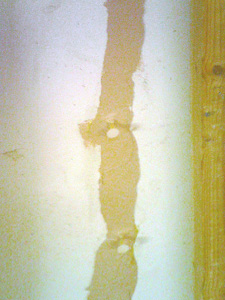FOUNDATION WALL CRACK INJECTION

All poured concrete, especially in this climate, is at risk of eventually cracking. Most is normal and often results from shrinkage and/or settlement of the concrete as it cures. Over time, though, some cracks may begin to seep. These basement leaks can be filled (injected) to prevent water, dirt, bugs, etc. from penetrating.
Epoxy is generally used when the concrete already has a great deal of steel rebar embedded in it for rigidity and is, therefore, not prone to movement caused by seismic activity. Large, commercial buildings and parking garages are examples of this type of rigid construction. While usually less expensive than urethane, epoxy is also generally less flexible when it comes to withstanding ground movement.
Hydrophobic, or water repellant, urethane (polyurethane) is used when greater ability to adjust to ground movement is required. Residential poured concrete foundations are almost never as rigidly constructed as commercial buildings so urethane, in its liquid form, is injected into the crack. As it cures, it expands in contact with air and water to fill the void in the concrete left by the crack.
It is important to note that a foundation wall crack may extend below the floor and through the footing (the base on which the walls rest). Because concrete is a porous material and wicks water from the ground - a typical yard of cured concrete can hold gallons of water - dark or damp spots may appear from time to time, especially when the ground is saturated. If there is enough pressure from the water beneath the floor, weeping or seepage may also occur. This is quite common and not a failure of the wall crack repair but, rather, an indication of sump pump slow down or failure or that the drain tile system may be overwhelmed by the volume of water it is trying to evacuate through the sump pit.
